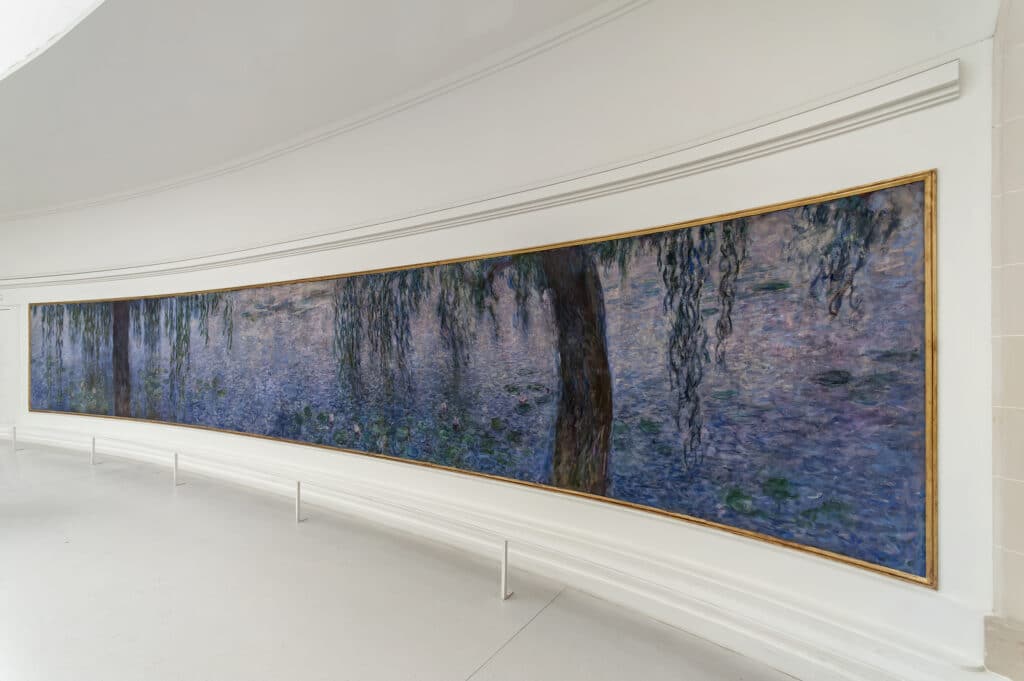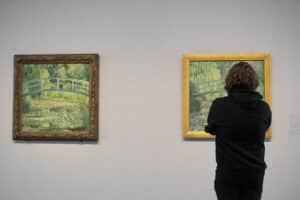
The general admission fee for Musée de l’Orangerie in 2025 is €12.50 for adults, while seniors (over 65) and students (under 26 with valid ID) pay a reduced rate of €10. Children under 18 can enter free of charge. The museum opens daily from 9:00 to 18:00, except on Tuesdays when it remains closed, and final admission is at 17:15. It also closes on May 1 and December 25. We visited on 12 February 2025, and all information reflects the situation on that date.
Historical Background and Notable Works
Originally constructed in 1852 under the direction of Napoleon III to protect orange trees during harsh winters, the building later evolved into an art museum showcasing prominent Impressionist and post-Impressionist works. One of its crowning achievements is Claude Monet’s Water Lilies series, displayed in two large oval rooms on the ground floor. These rooms were specifically designed to immerse visitors in Monet’s vision of water, light, and reflection, creating a serene atmosphere that offers a glimpse into the artist’s fascination with nature’s changing moods.
Beyond the Water Lilies, the museum houses the Jean Walter and Paul Guillaume collection, which includes masterpieces by artists such as Renoir, Cézanne, Picasso, Modigliani, and Matisse.
Museum Layout and Sections
The ground floor is primarily dedicated to Monet’s monumental murals, laid out in two elliptical galleries. We find that spending extra time here to observe Monet’s brushwork up close is especially rewarding, as the paintings seem to change depending on where viewers stand. Downstairs, the galleries of the Jean Walter and Paul Guillaume collection unfold chronologically, allowing visitors to trace the evolution of modern art. Sculptures and smaller paintings are displayed in an intimate setting, with descriptive panels that provide insights into each artist’s creative journey. We encourage pausing to compare the techniques and themes that unite or distinguish these artworks—this approach can enhance the overall experience and reveal hidden connections.

Musée de l’Orangerie
Visiting Tips and Observations
A typical visit takes about an hour to ninety minutes, though we recommend setting aside additional time if you wish to study the details of Monet’s large-scale compositions or explore the collection’s lesser-known gems. We also suggest stepping back and looking at Water Lilies from different angles to fully appreciate how light and color interact. The museum’s relatively compact size, compared to larger institutions in Paris, allows for a focused viewing without feeling rushed.

Musée de l’Orangerie
Nearby Attractions
Situated in the Tuileries Garden, Musée de l’Orangerie is perfectly located for a leisurely walk among the statues, fountains, and tree-lined paths. After exploring the museum, we suggest a short stroll to the Place de la Concorde and onward to the Champs-Élysées. Alternatively, the Louvre Museum stands nearby for those interested in an extended art-filled itinerary. For dining, Café Marly near the Louvre’s courtyard serves French classics in a refined setting, while Le Musset on Rue de Richelieu offers a more casual atmosphere with a varied menu. If you wish to rest or shop after your visit, the inviting cafés and stores around Rue de Rivoli provide numerous options for relaxation or souvenir hunting. We find that combining a visit to the museum with a peaceful break in the garden can create a balanced day of culture and leisurely discovery.

